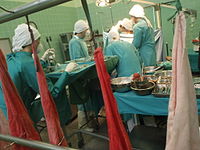
Photo from wikipedia
BACKGROUND The aim of this study was to assess risk factors for postoperative mortality after liver transplantation among patients with Model for End-Stage Liver Disease (MELD) scores ≥35, with special… Click to show full abstract
BACKGROUND The aim of this study was to assess risk factors for postoperative mortality after liver transplantation among patients with Model for End-Stage Liver Disease (MELD) scores ≥35, with special focus on the MELD scores. MATERIAL AND METHODS Data from 68 primary liver transplantations in patients with MELD scores ≥35 among 1376 liver transplantations performed in the Department of General, Transplant, and Liver Surgery (Medical University of Warsaw) between January 2002 and October 2014 were analyzed retrospectively. Postoperative (90-day) mortality was set as the primary outcome measure. RESULTS Postoperative mortality was 29.4% (20 of 68). The overall survival rates after 1, 5, and 10 years were 61.9%, 59.7%, and 59.7%, respectively. According to univariate analyses, MELD (p=0.014), conventional technique of liver transplantation (p=0.049), intraoperative fresh frozen plasma (p=0.040), and red blood cells (p=0.026) transfusions were risk factors for postoperative mortality. MELD score was the only independent risk factor for postoperative mortality (p=0.023) in multivariate analysis. According to receiver operating characteristics analysis, the optimal cut-off for MELD score in prediction of postoperative mortality was ≥43 (Area Under Curve=0.703, 95% Confidence Interval 0.575-0.831). Postoperative mortality was 21.4% and 42.3% among patients with MELD score <43 and ≥43, respectively (p=0.066). CONCLUSIONS MELD score is an important predictor of early mortality after liver transplantation, even among recipients with high MELD scores. In particular, patients with MELD score ≥43 should be considered as very high-risk candidates for liver transplantation.
Journal Title: Annals of transplantation
Year Published: 2017
Link to full text (if available)
Share on Social Media: Sign Up to like & get
recommendations!